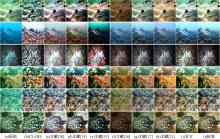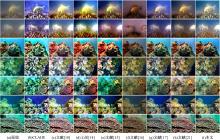Journal of Jilin University(Engineering and Technology Edition) ›› 2021, Vol. 51 ›› Issue (4): 1396-1404.doi: 10.13229/j.cnki.jdxbgxb20200431
Underwater image restoration based on multi-scale attention fusion and convolutional neural network
De-xing WANG( ),Ruo-you WU,Hong-chun YUAN(
),Ruo-you WU,Hong-chun YUAN( ),Peng GONG,Yue WANG
),Peng GONG,Yue WANG
- School of Information,Shanghai Ocean University,Shanghai 201306,China
CLC Number:
- TP391.4
| 1 | Meline A, Triboulet J, Jouvencel B. Comparative study of two 3D reconstruction methods for underwater archaeology[C]∥IEEE/RSJ International Conference on Intelligent Robots and Systems, Vilamoura, Portugal, 2012: 740-745. |
| 2 | Skarlatos D, Agrafifiotis P, Menna F, et al. Ground control networks for underwater photogrammetry in archaeological excavations[C]∥Proceedings of the 3rd IMEKO International Conference on Metrology for Archaeology and Cultural Heritage,Lecce, Italy, 2017: 23-25. |
| 3 | Chuang M C, Hwang J N, Williams K. A feature learning and object recognition framework for underwater fish images[J]. IEEE Transactions on Image Processing, 2016, 25(4): 1862-1872. |
| 4 | Shkurti F, Xu A, Meghjani M, et al. Multi-domain monitoring of marine environments using a heterogeneous robot team[C]∥IEEE/RSJ International Conference on Intelligent Robots and Systems,Vilamoura, Portugal, 2012: 1747-1753. |
| 5 | Wang X, Li Q, Yin J, et al. An adaptive denoising and detection approach for underwater sonar image[J]. Remote Sensing, 2019, 11(4): No.396. |
| 6 | Zeng L, Sun B, Zhang W, et al. Underwater Image Target Detection with Cascade Classifier and Image Preprocessing Method[C]∥International Conference on Intelligent Robotics and Applications, Shenyang, China, 2019: 195-205. |
| 7 | Güraksin G E, Köse U, Deperlioğlu Ö. Underwater image enhancement based on contrast adjustment via differential evolution algorithm[C]∥International Symposium on Innovations in Intelligent Systems and Applications, Sinaia, Romania, 2016: 1-5. |
| 8 | Henke B, Vahl M, Zhou Z. Removing color cast of underwater images through non-constant color constancy hypothesis[C]∥The 8th International Symposium on Image and Signal Processing and Analysis, Trieste, Italy, 2013: 20-24. |
| 9 | Ancuti C O, Ancuti C, de Vleeschouwer C, et al. Locally adaptive color correction for underwater image dehazing and matching[C]∥Proceedings of the IEEE Conference on Computer Vision and Pattern Recognition Workshops, Honolulu, USA, 2017: 1-9. |
| 10 | Zhang W, Li G, Ying Z. A New Underwater Image Enhancing Method via Color Correction and Illumination Adjustment[C]∥IEEE Visual Communications and Image Processing, USA: IEEE, 2017: 1-4. |
| 11 | Zou W, Wang X, Li K, et al. Self-tuning underwater image fusion method based on dark channel prior[C]∥IEEE International Conference on Robotics and Biomimetics, Qingdao, China, 2016: 788-793. |
| 12 | Chiang J Y, Chen Y C. Underwater image enhancement by wavelength compensation and dehazing[J]. IEEE Transactions on Image Processing, 2011, 21(4): 1756-1769. |
| 13 | Akkaynak D, Treibitz T. A revised underwater image formation model[C]∥Proceedings of the IEEE Conference on Computer Vision and Pattern Recognition, Salt Lake City, USA, 2018: 6723-6732. |
| 14 | Li C Y, Guo J C, Cong R M, et al. Underwater image enhancement by dehazing with minimum information loss and histogram distribution prior[J]. IEEE Transactions on Image Processing, 2016, 25(12): 5664-5677. |
| 15 | Berman D, Levy D, Avidan S, et al. Underwater Single Image Color Restoration Using Haze-Lines and a New Quantitative Dataset [EB/OL]∥[2020-06-13]. . |
| 16 | Li C, Anwar S, Porikli F. Underwater scenes prior inspired deep underwater image and video enhancement[J]. Pattern Recognition, 2020, 98: 107038. |
| 17 | Li C, Guo C, Ren W, et al. An Underwater Image Enhancement Benchmark Dataset and Beyond [EB/OL]. [2020-06-13]. . |
| 18 | 徐岩, 孙美双. 基于卷积神经网络的水下图像增强方法[J]. 吉林大学学报:工学版, 2018, 48(6): 1895-1903. |
| Xu Yan, Sun Mei-shuang. Underwater image enhancement method based on convolutional neural network[J]. Journal of Jilin University (Engineering and Technology Edition), 2018, 48(6): 1895-1903. | |
| 19 | Li J, Skinner K A, Eustice R M, et al. WaterGAN: Unsupervised generative network to enable real-time color correction of monocular underwater images[J]. IEEE Robotics and Automation Letters, 2017, 3(1): 387-394. |
| 20 | Lu J, Li N, Zhang S, et al. Multi-scale adversarial network for underwater image restoration[J]. Optics & Laser Technology, 2019, 110: 105-113. |
| 21 | Islam M J, Xia Y, Sattar J. Fast underwater image enhancement for improved visual perception[J]. IEEE Robotics and Automation Letters, 2020, 5(2): 3227-3234. |
| 22 | Zhang B, Jin S, Xia Y, et al. Attention Mechanism Enhanced Kernel Prediction Networks for Denoising of Burst Images[C]∥IEEE International Conference on Acoustics, Speech and Signal Processing (ICASSP), 2020: 2083-2087. |
| 23 | Chen D, He Z, Cao Y, et al. Deep neural network for fast and accurate single image super-resolution via channel-attention-based fusion of orientation-aware features [EB/OL].[2020-06-13]. . |
| 24 | Li H, Qiu K, Chen L, et al. SCAttNet: semantic segmentation network with spatial and channel attention mechanism for high-resolution remote sensing images[J]. IEEE Geoscience and Remote Sensing Letters, 2020,18(5):905-909. |
| 25 | Woo S, Park J, Lee J Y, et al. Cbam: Convolutional block attention module[C]∥Proceedings of the European Conference on Computer Vision (ECCV), Munich, Germany, 2018: 3-19. |
| 26 | Hautière N, Tarel J P, Aubert D, et al. Blind contrast enhancement assessment by gradient ratioing at visible edges[J]. Image Analysis & Stereology, 2008, 27(2): 87-95. |
| 27 | Liu L, Liu B, Huang H, et al. No-reference image quality assessment based on spatial and spectral entropies[J]. Signal Processing: Image Communication, 2014, 29(8): 856-863. |
| 28 | Mittal A, Soundararajan R, Bovik A C. Making a "completely blind" image quality analyzer[J]. IEEE Signal Processing Letters, 2012, 20(3): 209-212. |
| 29 | Liu L, Hua Y, Zhao Q, et al. Blind image quality assessment by relative gradient statistics and adaboosting neural network[J]. Signal Processing: Image Communication, 2016, 40: 1-15. |
| 30 | Panetta K, Gao C, Agaian S. Human-visual-system-inspired underwater image quality measures[J]. IEEE Journal of Oceanic Engineering, 2015, 41(3): 1-11. |
| [1] | Ya-hui ZHAO,Fei-yang YANG,Zhen-guo ZHANG,Rong-yi CUI. Korean text structure discovery based on reinforcement learning and attention mechanism [J]. Journal of Jilin University(Engineering and Technology Edition), 2021, 51(4): 1387-1395. |
| [2] | Hou⁃jie LI,Fa⁃sheng WANG,Jian⁃jun HE,Yu ZHOU,Wei LI,Yu⁃xuan DOU. Pseudo sample regularization Faster R⁃CNN for traffic sign detection [J]. Journal of Jilin University(Engineering and Technology Edition), 2021, 51(4): 1251-1260. |
| [3] | Hua-wei JIANG,Zhen YANG,Xin ZHANG,Qian-lin DONG. Research progress of image dehazing algorithms [J]. Journal of Jilin University(Engineering and Technology Edition), 2021, 51(4): 1169-1181. |
| [4] | Jing JIN,Jian-wu DANG,Yang-ping WANG,Dong SHEN. Multi⁃cue particle filter tracking based on fuzzy statistical texture features [J]. Journal of Jilin University(Engineering and Technology Edition), 2021, 51(3): 1111-1120. |
| [5] | Yuan-ning LIU,Di WU,Xiao-dong ZHU,Qi-xian ZHANG,Shuang-shuang LI,Shu-jun GUO,Chao WANG. User interface components detection algorithm based on improved YOLOv3 [J]. Journal of Jilin University(Engineering and Technology Edition), 2021, 51(3): 1026-1033. |
| [6] | Hai-ying ZHAO,Wei ZHOU,Xiao-gang HOU,Xiao-li ZHANG. Double-layer annotation of traditional costume images based on multi-task learning [J]. Journal of Jilin University(Engineering and Technology Edition), 2021, 51(1): 293-302. |
| [7] | Hong-wei ZHAO,Xiao-han LIU,Yuan ZHANG,Li-li FAN,Man-li LONG,Xue-bai ZANG. Clothing classification algorithm based on landmark attention and channel attention [J]. Journal of Jilin University(Engineering and Technology Edition), 2020, 50(5): 1765-1770. |
| [8] | Guo-hua LIU,Wen-bin ZHOU. Pulse wave signal classification algorithm based on time⁃frequency domain feature aliasing using convolutional neural network [J]. Journal of Jilin University(Engineering and Technology Edition), 2020, 50(5): 1818-1825. |
| [9] | Ke-yan WANG,Di WANG,Xi ZHAO,Jing-yi CHEN,Yun-song LI. Image dehazing based on joint estimation via convolutional neural network [J]. Journal of Jilin University(Engineering and Technology Edition), 2020, 50(5): 1771-1777. |
| [10] | Zai-feng SHI,Jin-zhuo LI,Qing-jie CAO,Hui-long LI,Qi-xing HU. Low⁃dose spectral computer⁃tomography imaging denoising method via a generative adversarial network [J]. Journal of Jilin University(Engineering and Technology Edition), 2020, 50(5): 1755-1764. |
| [11] | Xiang-jiu CHE,You-zheng DONG. Improved image recognition algorithm based on multi⁃scale information fusion [J]. Journal of Jilin University(Engineering and Technology Edition), 2020, 50(5): 1747-1754. |
| [12] | Hua CHEN,Wei GUO,Jing-wen YAN,Wen-hao ZHUO,Liang-bin WU. A new deep learning method for roads recognition from SAR images [J]. Journal of Jilin University(Engineering and Technology Edition), 2020, 50(5): 1778-1787. |
| [13] | Wei ZHANG,Yong HAN,Ming JIN,Xiao-lin QIAO. Toeplitz matrices reconstruction based DOA estimation for coherent signals [J]. Journal of Jilin University(Engineering and Technology Edition), 2020, 50(2): 703-710. |
| [14] | Yan-fen CHENG,Li-juan YAO,Qiao YUAN,Xian-qiao CHEN. Clearing strategy of underwater video image [J]. Journal of Jilin University(Engineering and Technology Edition), 2020, 50(2): 668-677. |
| [15] | Xiao-hui YU,Zhi-cheng ZHANG,Xin-bo LI,Xiao-dong SUN. Parameter estimation of exponentially damped sinusoidsbased on state⁃space model [J]. Journal of Jilin University(Engineering and Technology Edition), 2019, 49(6): 2083-2088. |
|
||









